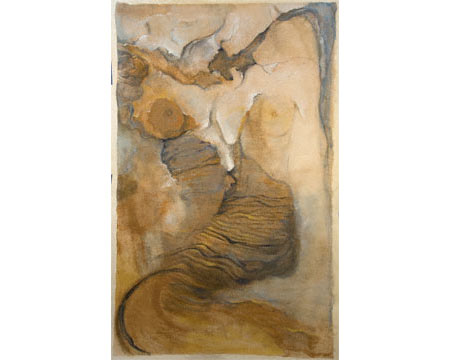
Mary Heebner uses sepia toned pigments, laid down loose and watery over passages of graphite to limn gestural, amorphous nude figures. Most are female, but a few are intentionally less gender specific. We often don’t see heads or faces, because the scale, if not the size, extends figures beyond the page — a compositional tactic that makes the nudes wholly generic and serves an eventual goal.
That goal is to somehow allude to some irrefutably visceral body-ness using rhythmic hints of torsos, breasts, thighs, backs, pelvis — while never invoking any tangible “lived” body, only its “life energies.” This slippery content is aided by a sometimes effective, sometimes hackneyed tool: having parts of figures blend with and emanate from barest abstract suggestions of enduring nature, for example calcareous rock, something that looks like tree bark, or vaporous fields. In “Wetland Muse,” a lovely female torso flows out from or melds with the mere suggestion of a growing tree trunk. It is not so much Daphne turning into a tree to avoid seduction as it is a visual lacing of the embodied — that would be us — and the cosmos.
That said, Heebner's tactic of merging these nudes with abstracted references to nature links two old Enlightenment ideas implicit in the symbol “Mother Nature:” females are the fecund unpredictable forces of nature, men then, by contrast, are the de facto stand-ins for the rational, for timeless abstract thought. To complicate matters, titles primarily use the word “muse” — itself a construct that carries deeply rooted classical notions of one gender making culture and one gender passively inspiring the makers of culture.
It’s courageous and difficult to take on the nude figure today, a form associated with long vacated and over investigated Academic traditions. Further, when Post Modernity tolerates the figure, it is mainly via conceptual photos or hyper real paintings designed to derail our very human reflex to imagine the body as something essential. The last thirty years of figurative art invited us to consider instead that our understanding of the body and of ourselves through it come, not from intrinsic givens that make certain bodies “ordered” and certain others “fruitful,” but rather via imagistic representations that teach us these tropes.
Using the lyrically drafted, classically based nude – pre-packaged today with so many loaded ideas in art and culture, like the gendered corpus, woman as Gaia, sexuality — Heebner opens a can of worms that we simply cannot ignore.
The best works save themselves because they indicate an intended or unintended awareness of all the aesthetic and ideological baggage that figurative (female) nudes hold. The works seem to play on and not simply reiterate the Western Classical mind-body split, with its gendered Cartesian separation of masculine reason over feminine senses, soul over willed action, transcendence and thought over the contingencies of biological nature.
Heebner pushes back against this problematic read with torsos not bound by fixed contours, that bleed into and become, via sound draftsmanship, other types of biology. Fossils, flora or primordial atmospheres seem to enclose, deliver up or overtake figures that are – by the artist's intent – not bodies in themselves, but systems bound within bigger systems: cosmological, geological, ecological, aesthetic. If we read it correctly, the concept here is some formal and by inference experiential wholeness to reality set to counter Age of Reason dualities.
It’s almost amusing that this whole conundrum of body-creation-soul-universe is still such a big deal for Western art and critical thought when you think that Asian cultures have for millennia seen lingam-yoni, ying-yang as the ‘one-thing’ behind all things — bodies, consciousness, nature, cosmos, culture. With her columnar erect forms and rotund flowing forms coalescing by skilled intent in these works, Heebner hints at this holistic view, however it's got a distinctly feminine force pulsating at its center.
The metaphor is at times carried so far and so literally that results are disastrous — e.g., a supernova of pigment spits out silly little hands. But when it works, this is an audacious attempt by an artist who’s clearly mastered the age old skill of life drawing sufficiently well to be confident, expressive and eccentric with its accepted forms and social codes.
Published courtesy of ArtScene ©2010
